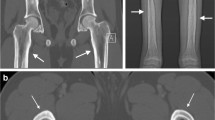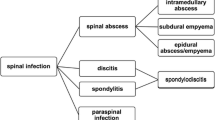Summary
Eosinophilic granuloma (EG) is a rare disease but is more common in adults than children. It’s often self-limiting. Spinal involvement is rare. It is the localized and most benign form of Langerhans’ cell histiocytosis (previously known as histiocytosis X), characterised by lytic lesions in one or more bones. Spontaneous resolution of vertebral body lesions is very rare. In this case, the patient had one EG in a cervical vertebra and a similar lesion in a lumbar vertebra. This case is important because it featured a symptomatic lesion in the cervical spine accompanied by an asymptomatic lesion in a lumbar vertebra. We treated the cervical lesion by surgical fusion and followed the lumbar lesion up conservatively, with the patient in a corset. After 8 years of follow-up, control MRI showed that the lumbar lesion had spontaneously resolved.
Similar content being viewed by others
Author information
Authors and Affiliations
Rights and permissions
About this article
Cite this article
Bavbek, M., Atalay, B., Altınörs, N. et al. Spontaneous resolution of lumbar vertebral eosinophilic granuloma. Acta Neurochir 146, 165–167 (2004). https://doi.org/10.1007/s00701-003-0182-3
Published:
Issue Date:
DOI: https://doi.org/10.1007/s00701-003-0182-3




